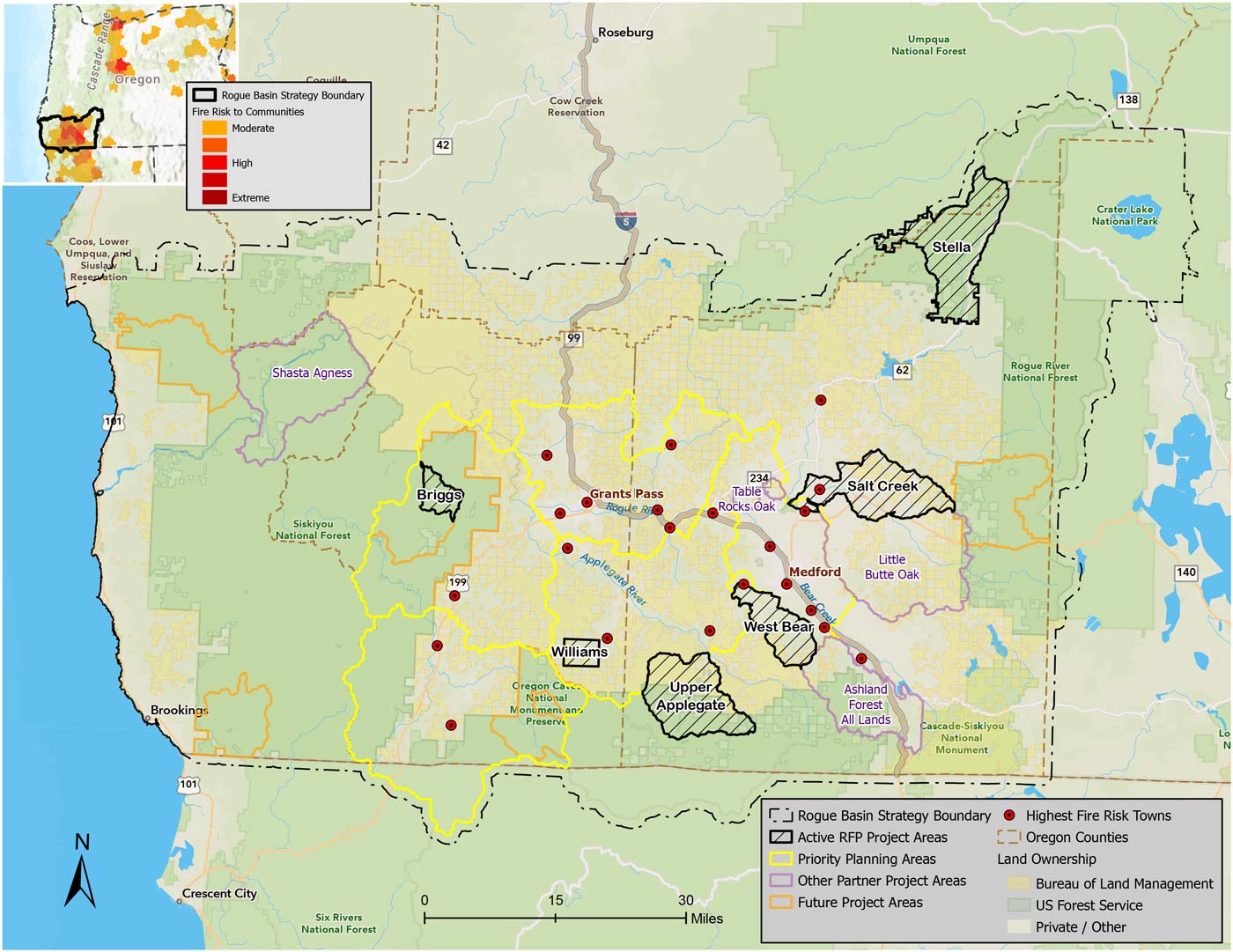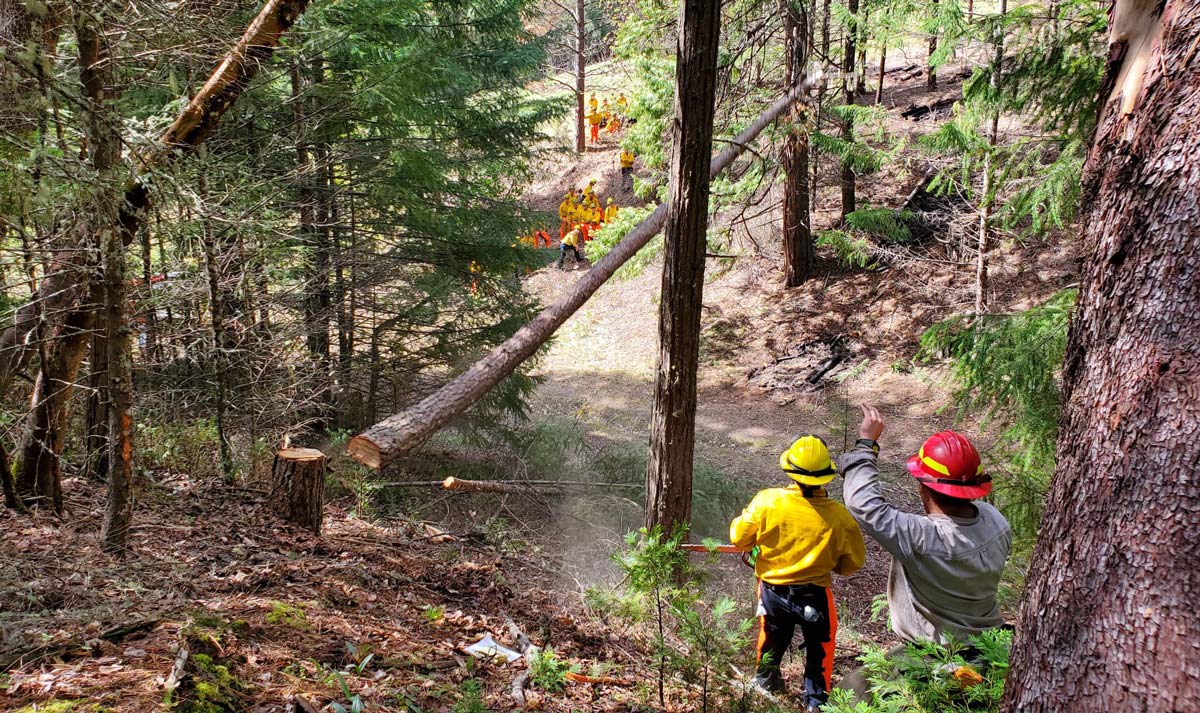Upper Briggs Project
Located in Josephine County, west of Grants Pass, on the Rogue River-Siskiyou National Forest, our Upper Briggs Restoration Project is situated on the Briggs Creek watershed. In addition to benefiting a key salmon-bearing tributary to the Illinois River, the project area will also address a mixed conifer forest adjacent to the Shan Creek community to the east.
Rogue Forest Partners have secured initial funding to treat approximately 350 acres in Shan Apple, to improve the overall resiliency of the Briggs Creek watershed to wildfire and the impacts of climate change.
Where:
Josephine County, west of Grants Pass and situated on the Briggs Creek watershed.
When:
Marking began over the summer of 2022 and ecological thinning operations are scheduled to start in the fall of 2022.
Why:
Reduce wildfire risk to communities by creating a more resilient landscape through strategic ecological treatments and fuels management.
Scope:
350+ strategically targeted acres in a 3,000-acre footprint
The removal of indigenous people as the primary land stewards and the subsequent fire suppression regime of the past century have created dense, overgrown forests that pose a significant wildfire risk to the ecosystem and nearby communities.
The Upper Briggs restoration project will reduce the risk of severe wildfire to the Illinois Valley and Grants Pass communities while improving forest health and biodiversity.
It will help protect forests and riparian reserves through strategic ecological thinning, including reducing ladder fuels and using prescribed burning. These restoration treatments will restore appropriate tree density to reduce the risk of severe wildfires, protect large older legacy trees, and improve local flora and fauna habitat while safeguarding ecosystem services vital to adjacent communities.
Healthier forests, healthier habitats
Within the Upper Briggs project area, you’ll find several rare plants, including Siskiyou fritillaria, Applegate’s gooseberry, and California pitcher plant. In addition to other rare and unusual grasses, forbs, and shrubs, Native bird species, such as the Northern Spotted Owl, and threatened mammals such as the Pacific Fisher call this region home.
The recommended thinning treatments prioritize lower tree density and spacing, similar to pre-fire suppression conditions. They are also consistent with recommendations included in the “Restoring Dry Forest Ecosystems” section of the Revised Recovery Plan for the Northern Spotted Owl.
The RFP Upper Briggs project includes approximately 200 acres of commercial ecological thinning. As a stewardship-based project, timber removed as the by-product of restoration will be sold to local mills, with the revenue reinvested into the project, including the future application of prescribed fire. Local contractors completed the project layout and marking in the summer of 2022, with ecological thinning operations scheduled to start in the fall of 2022.
The Upper Briggs Decision Notice authorizes over 5,000 acres of treatment, including fuels management, riparian restoration, pine-oak restoration, rare plant enhancement, meadow restoration, and enhancement of late seral habitat. The Wild Rivers District will use various methods to implement some of this work funded by agreements with the Rogue Forest Partners.
The Rogue Basin communities, woodlands, and forests are at risk of uncharacteristic fire and no one organization can manage this risk. The Rogue Forest Partners share a common vision, seeking to restore forests and reduce risk by applying ecological restoration and bringing fire back as a tool.
Terry Fairbanks, Southern Oregon Forest Restoration Collaborative
RFP Project Areas
RFP has identified six projects across the Rogue Basin. These high-priority areas, spanning public land and private tracts, are critically important for reducing the risks of extreme wildfires, promoting climate adaptation, and restoring resilience to our landscape. The work began in the Applegate and Illinois Valleys in 2020 and continues into 2025.

The Upper Briggs Restoration Project on the Wild Rivers District in the Illinois Valley supports diverse habitats and forest conditions. This ridge burned in the Klondike/Taylor fire, but from ridge to stream, one encounters legacy trees to protect, dense understories to be thinned and chaparral patches intermixed. The ridgeline is important for managing fires moving from wildlands toward Illinois Valley communities.
The Williams Project near the community of Williams in Josephine County is focused on reducing fuels and improving forest habitat through restoration treatments on federal and private lands in an all-lands effort bringing together the BLM and NRCS with the RFP to demonstrate restorative wildfire risk reduction. Together, we are working toward the landscape-vision of the RBS.
The West Bear Project addresses the need for wildfire fuels reduction immediately adjacent to the cities of Jacksonville, Phoenix, Talent, and Medford. The 27,000-acre project area within the wildland urban interface west of Bear Creek and the I-5 corridor is one of the most at-risk locations for wildfire in Oregon.
The 50,000-acre USFS and BLM Upper Applegate Watershed Project (UAW) is located in the Applegate Valley with over 18,000 acres of planned restoration treatments designed during a three-year community planning process convened by the Siskiyou Mountains Ranger District of the RRSNF. Some 3500 acres are scheduled by RFP to be completed by 2025. The UAW is one of the highest priority areas for restoration under the RBS.
The Stella Landscape Restoration Project project occurs in the most productive corner of the Rogue Basin, where the lack of low-intensity fire and past management has resulted in high-density stands and declining forest health. To improve wildlife habitat and forest health and build ecosystem resilience to wildfire, the Stella Project will strategically apply ecological thinning (both non-commercial and commercial) and prescribed fire to achieve restoration goals across a 43,955-acre footprint.
The Salt Creek Project planning area is large but RFP work with the BLM starts with a small footprint of fuels treatments in oak woodlands. The treatments will demonstrate ecological restoration under the RBS in these dry but diverse oak habitats and help reduce wildfire risks near the communities of Eagle Point.

